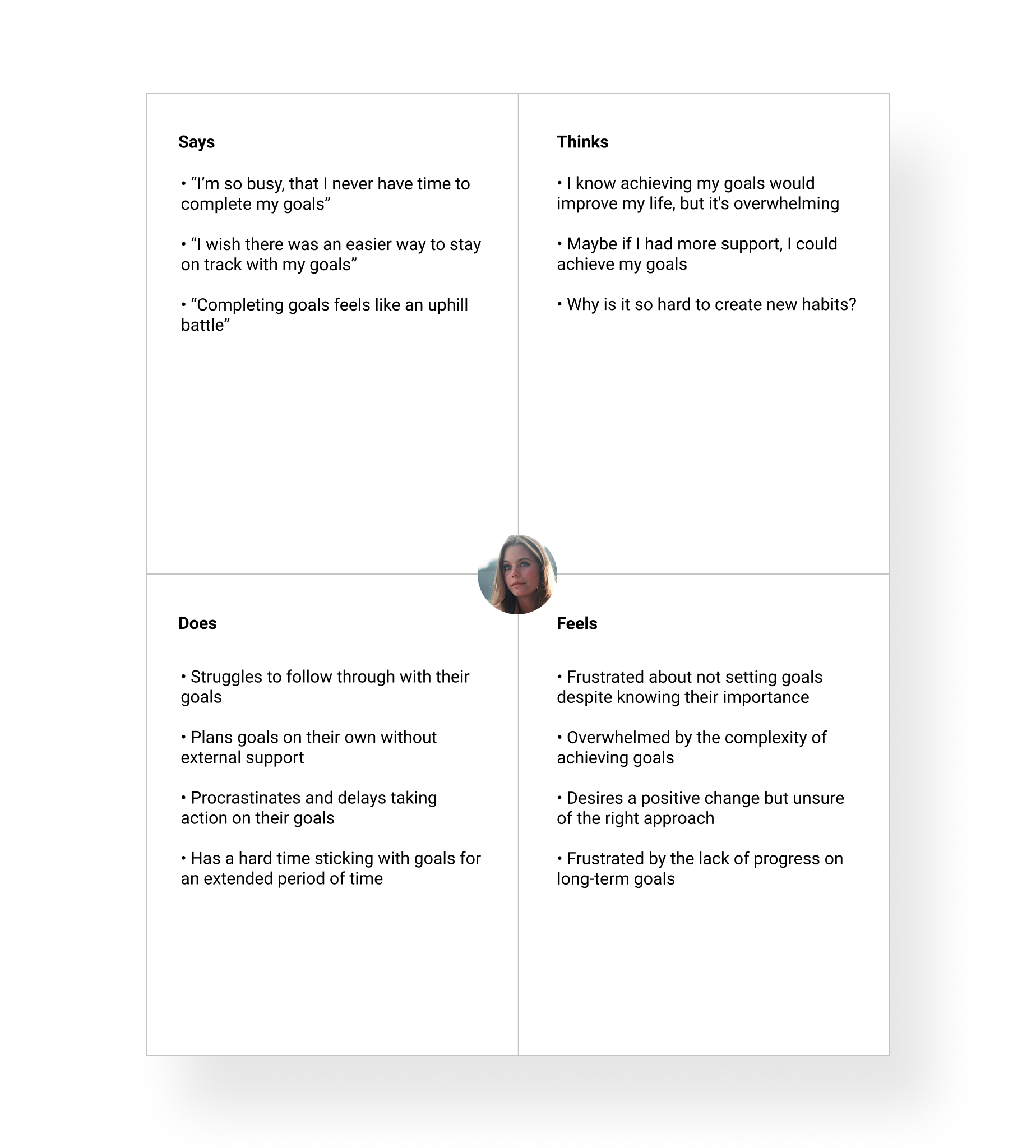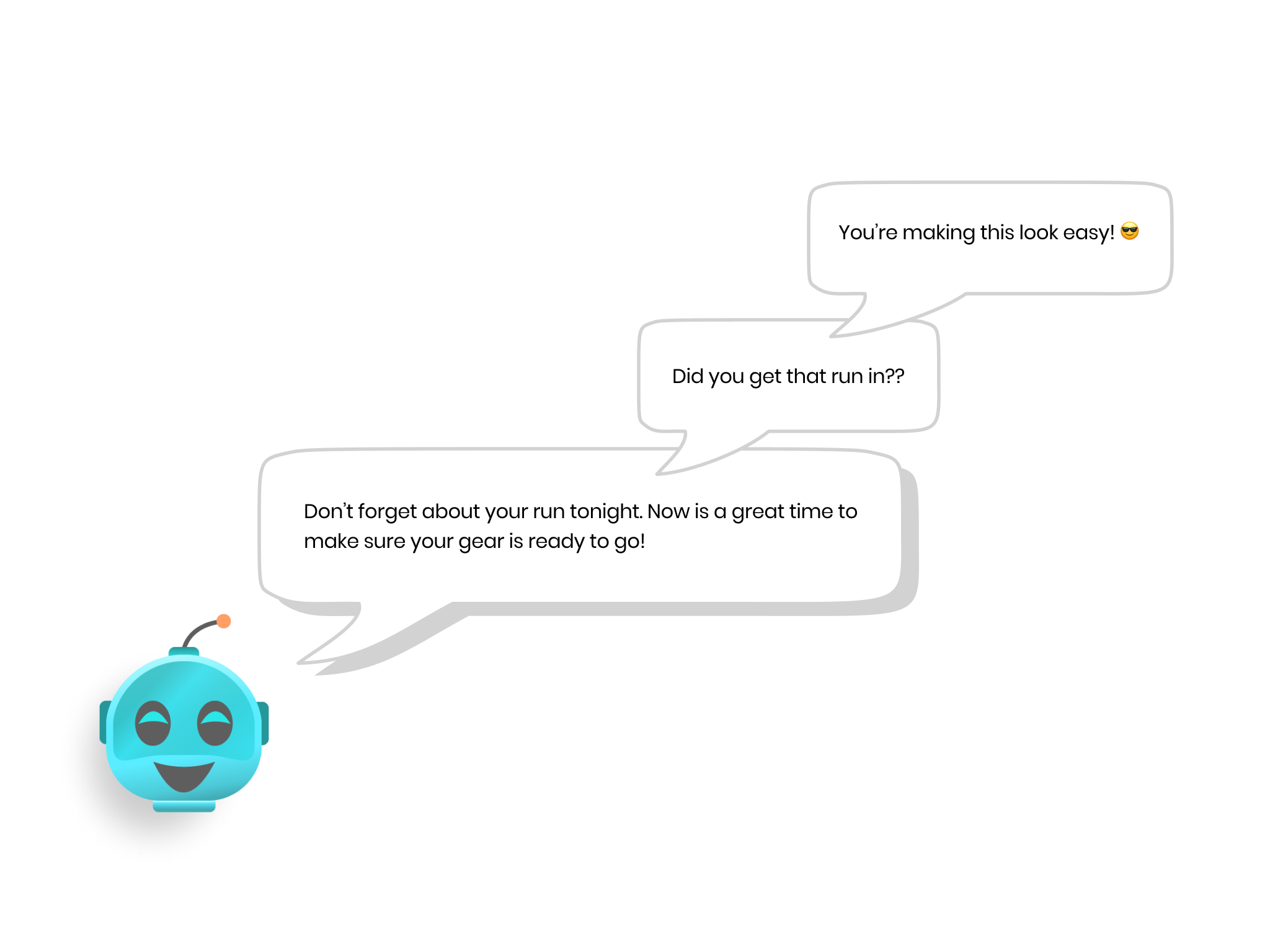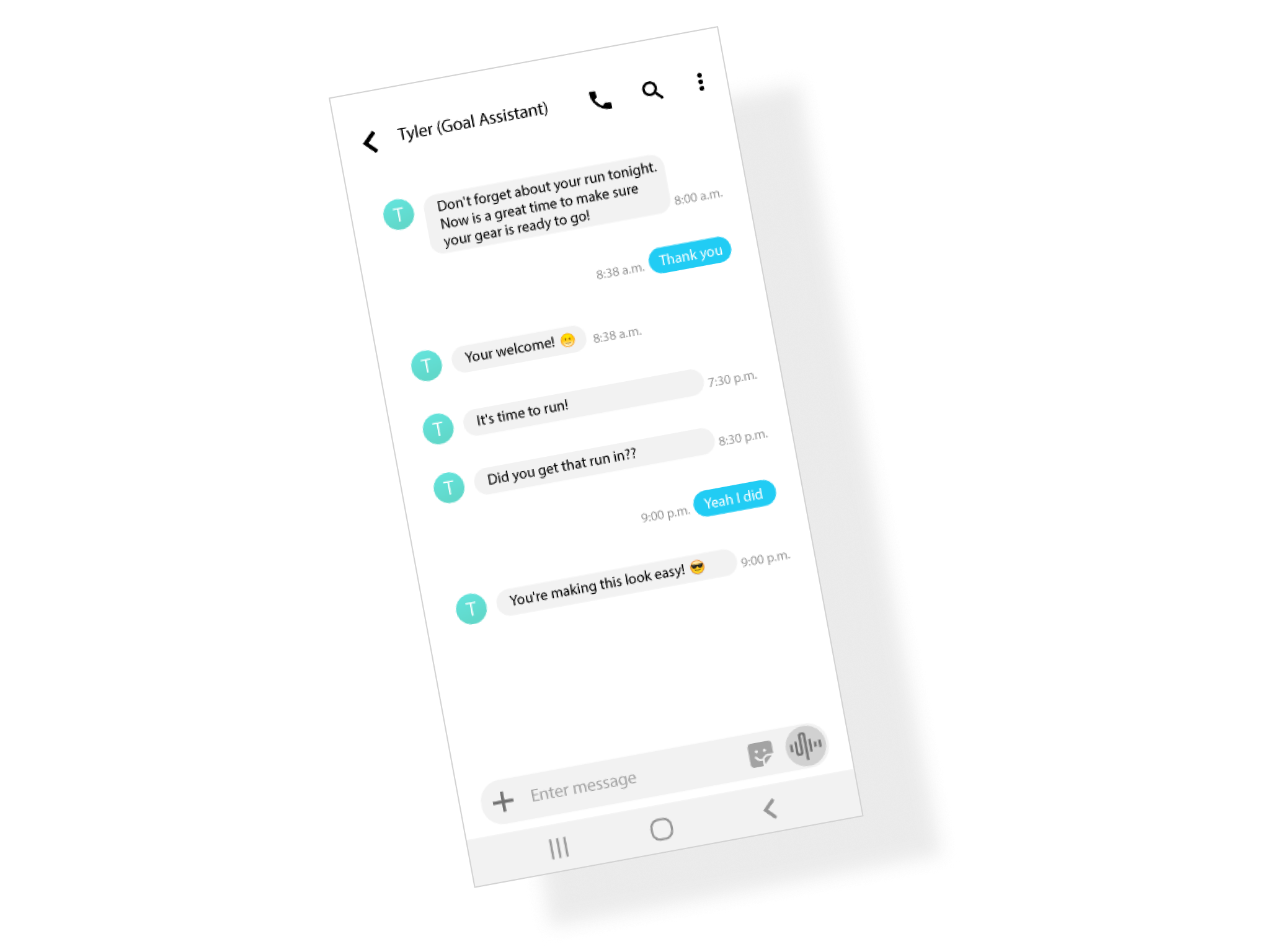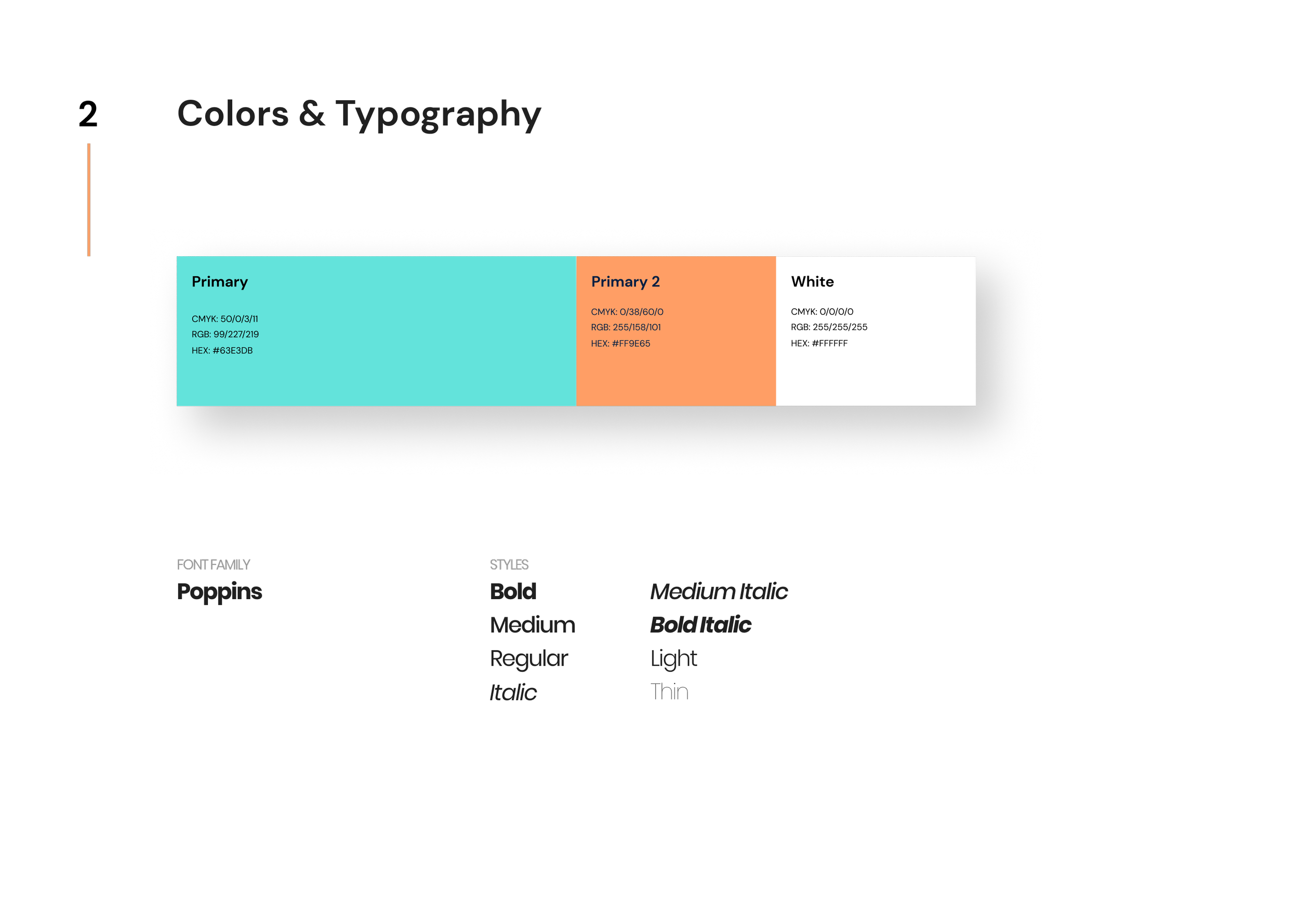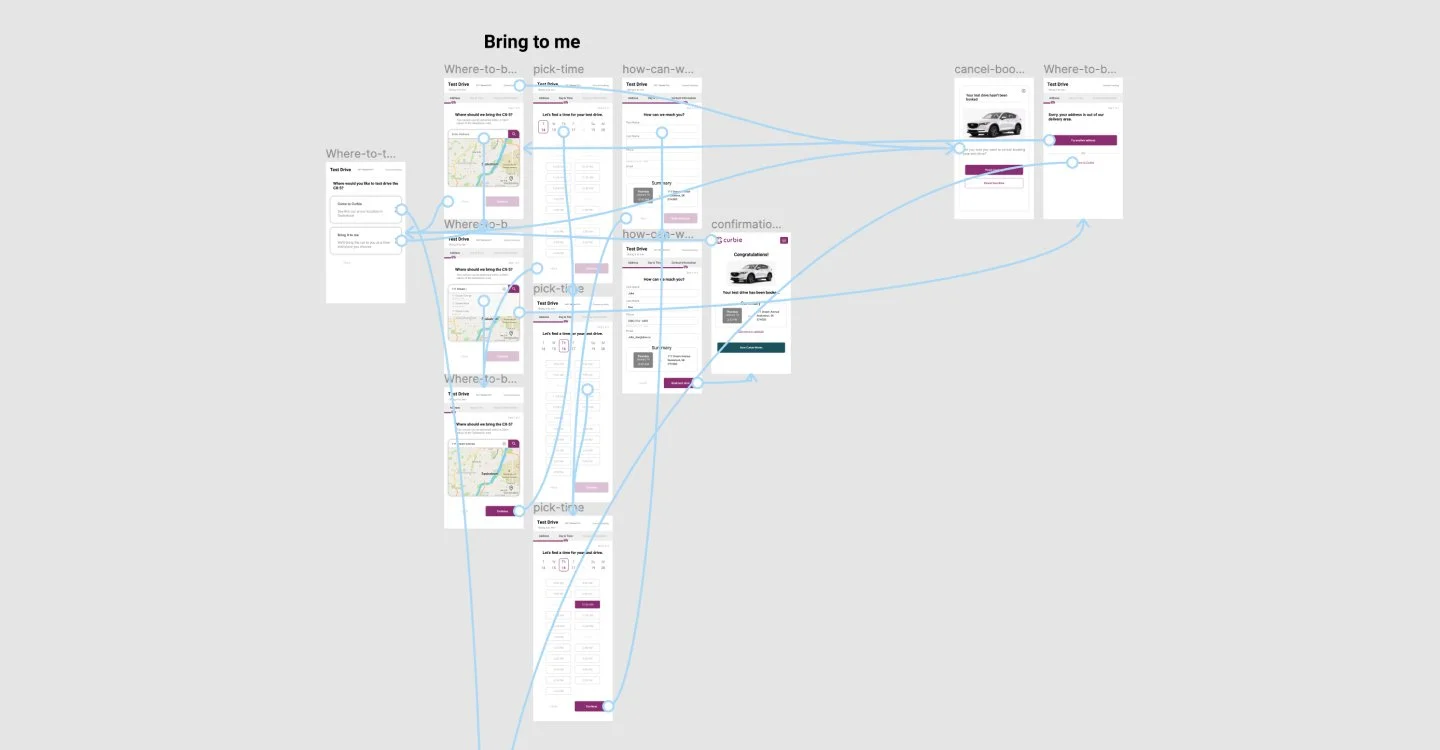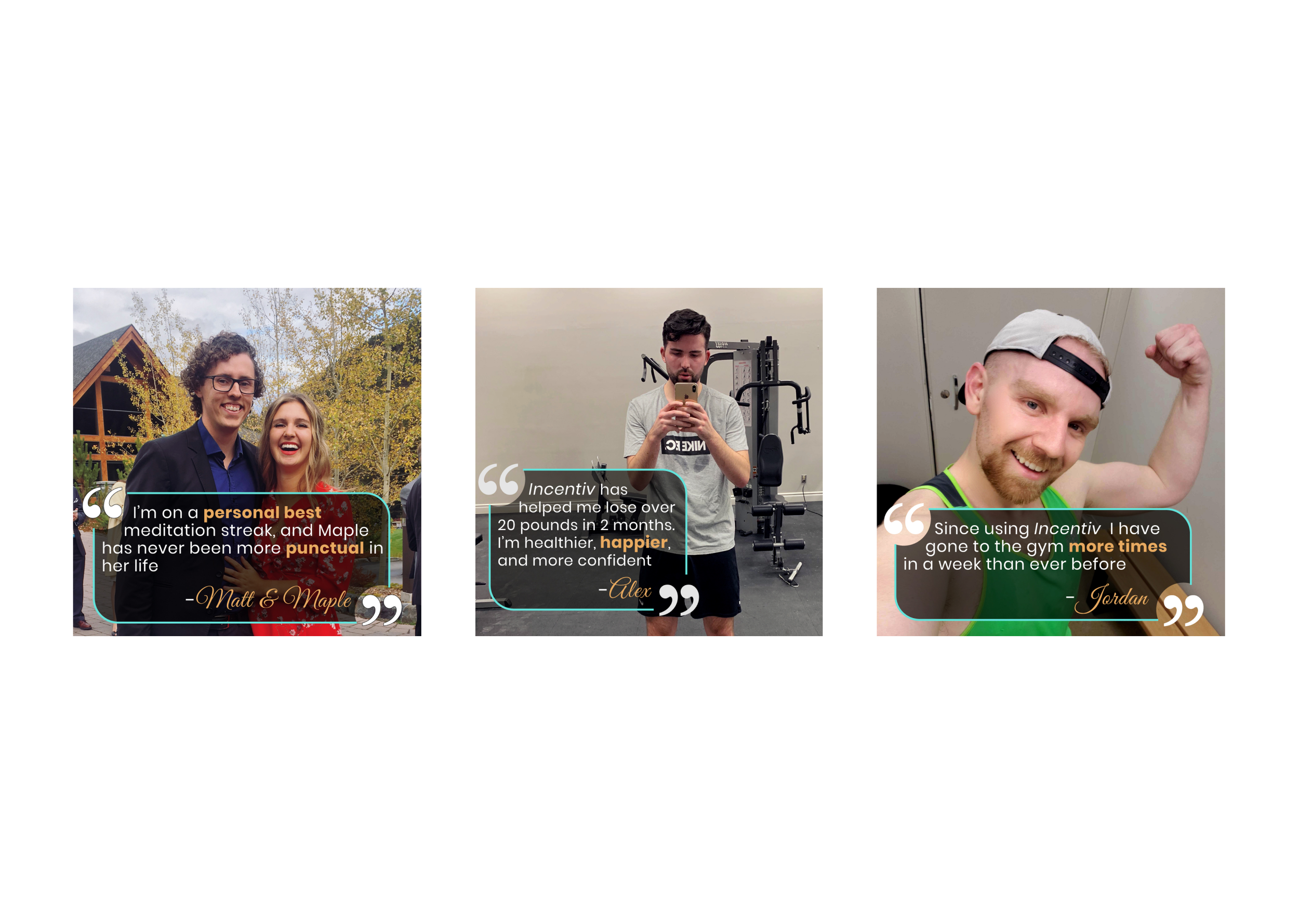
Incentiv
Create a way for users’ to find a vehicle that’s right for them
What’s the problem
Despite knowing that setting goals is important for a better life, a whopping 80 percent of people never bother setting any. Even among the 20 percent who do set goals, around 70 percent fail to achieve them.
Achieving goals can be a complex journey with various challenges. Insufficient planning and a lack of understanding on how to transform a new behavior into a lasting habit can hinder progress. Without accountability, staying on track and following through with goals becomes a significant challenge.
Few goal accountability apps provide comprehensive assistance, leaving individuals to navigate the challenges of remembering tasks amidst a busy life, planning on their own, self-tracking progress, and ultimately, finding self-motivation.
How might we help people achieve their goals and live more meaningful lives?
Solution
Incentiv is a dedicated goal accountability app crafted to empower individuals to achieve their goals. Users have the flexibility to choose a goal, determine the frequency, and receive intelligent reminders, maximizing their chances of success. Leveraging an empathetic chatbot, Incentiv ensures goal reminders are delivered via thoughtful text messages at intuitively timed moments. Additionally, the app allows users the convenience of rescheduling their goals when life presents unavoidable challenges. With Incentiv, goal pursuit becomes a personalized and adaptable journey.
Role
I led the end-to-end design process as the Product Designer, conducting research, crafting wireframes and prototypes, and working closely with developers during implementation.
Team
CEO, Product Designer, Developer, Marketing Manager

Research
Why do people set goals?
Most people want to see some kind of change or improvement in their lives from time to time. Setting goals is an effective way to increase motivation and to help create the changes you want.
Setting goals not only provides a sense of purpose but also leads to higher levels of happiness and life satisfaction, with a positive impact on mental health; individuals who achieve personal goals report increased feelings of well-being and positive emotions.
People who have goals are 10 times more likely to succeed
12% Increase in happiness and mental health
11 - 25% increase in productivity and performance
Only 30% succeed
Only about 30% of people who set goals will succeed in completing them.
Why? It takes time to form a new habit. It takes about 21 to 66 days for a new behavior to become automatic and ingrained as a habit. Some common challenges in habit formation include lack of motivation, unrealistic goal setting, and failure to establish a routine. External factors, such as changes in environment or routine disruptions, can also impact the formation of a habit.
How to help people succeed
According to a study by Dr. Gail Matthews at Dominican University of California, people who write down their goals, share them with a friend, and have regular check-ins are 33% more likely to achieve their goals than those who simply set goals.
Accountability is very important to the likelihood of achieving your goals. Sharing your goals with someone can create a sense of responsibility and motivation. Regular check-ins and progress tracking play a crucial role in maintaining accountability.
“Can you walk me through your process of setting and planning a goal?”
-Interview question
Interviews
I wanted to find out more about how people set and achieve their goals. I initiated a series of interviews with a diverse group of individuals. The main goal was to explore the feelings and motivations behind how they set and plan their goals.
Interview objectives
Understand how users currently set and plan goals
Learn about the challenges people face when setting goals
Personas
Based on the interviews/user research, I created personas that represent our users' distinct wants, and frustrations. These personas played a key role in the entire product development journey, guiding my design decisions to prioritize user needs. Personas are crucial as they make the design process more human and relatable, providing a clear picture of our end users. They foster empathy, ensuring the design aligns with the real needs and behaviors of our user base.

Individuals striving for better mental health and well-being need support in following through with their goals because traditional goal-setting often fails to overcome common challenges like lack of motivation, habit formation, and routine disruptions
— POV Statement
Competitive analysis
To understand the goal accountability market better, I thoroughly studied our competitors. This analysis helped me identify their strengths and areas where we could improve. Some opportunities we spotted were that competitors didn't allow users to reschedule goals, making their systems less adaptable to people’s busy lives. Their reminders were not user-friendly, often arriving untimely through emails or in-app notifications. To stand out, we made our reminders smart, tailored to each goal, and sent via SMS, offering a more personalized and supportive experience, like having a friend helping you stay on track.

Design
User flow
I created user flows to map out every step of the user interaction required to achieve their goals. “As a user, I want to search and find a vehicle that works for my lifestyle.” The user flow helps to understand the process thoroughly and ensure complete coverage when designing wireframes.
Experiment
Before committing extensive resources to design and development, it was crucial to validate our app's appeal and user interest. Through a "man-behind-the-curtain" experiment, we assumed the chatbot role, sending timely reminders to a select group. Two weeks into the experiment, the group reported positive experiences. To gauge their genuine interest in the service, we informed them that a monthly fee would be required. Almost all of them agreed and paid for the service.
This initial success provided strong validation for the idea's viability, instilling confidence to proceed with further development.
MVP
The Minimum Viable Product (MVP) stands as a crucial step in concept validation and risk mitigation before committing extensive resources to development.
For our app's beta launch, key functionalities included:
Account Creation: Gathering essential information such as name, phone number, and timezone to facilitate SMS messaging.
Goal and Habit Exploration: Offering users a curated list of common goals.
Timely Goal Reminders: Developing a system capable of sending intuitive and timely reminders aligned with users' selected goals, ensuring a supportive and engaging experience.
Sketching
For this project, I chose to begin with pencil and paper before transitioning to Figma. This approach allowed me to work swiftly without getting bogged down by pixel-perfect details or color considerations. I sketched out components and elements based on my competitive analysis using paper, enabling rapid iteration and easy swapping of elements to explore multiple variations. This process helped me identify which elements could work well together and create a fresh yet user-friendly interface. (Regrettably, I don't have any images of the paper components, elements, or sketches to share.)
Wireframes
I proceeded to refine the most promising choices and transitioned them into Figma for further development.
Chatbot creation
Creating an empathetic chatbot was important to our goal accountability app, aiming to offer users a supportive and friend-like experience. The chatbot was designed to engage in conversations that conveyed empathy, support, and helpfulness.
To do this we needed to have:
Personalized Reminders: Each goal was equipped with personalized reminders, strategically timed to optimize the user's chances of following through. The timing considered factors such as goal difficulty and habit formation.
Strategic Pre-Reminders: Recognizing the value of pre-reminders, especially for morning goals like workouts, the system would send helpful prompts the night before, fostering preparedness and success.
Timezone Awareness: Timely reminders were enhanced by timezone awareness, ensuring that users received customized prompts based on their specific morning, afternoon, or evening goal schedules.
Randomized Responses: To humanize the chatbot interactions, responses were diversified. Randomizing responses from a pool of options added variety, preventing predictability and contributing to a more natural and engaging experience.
Branding & Visual Identity
As a company, we needed to create a consistent visual identity and a strong brand. We worked closely with an agency to help with the rebranding of Curbie. I led the rebranding and created a design system to make sure everything looked and felt like Curbie. The style guide underwent many iterations to incorporate design principles and accessibility standards.




High-fidelity wireframes
Using the newly established style guide and design system, I updated the wireframes and brought the envisioned design to life with our new identity. High-fidelity wireframes allow me to visualize the product's final look and feel, and facilitate more informed discussions.

Test
Prototype and User Testing
I created prototypes to assess the flow and identify usability issues and we made a live version of the chatbot for practical testing. This level of prototyping ensured a more accurate representation of the brand and facilitated higher-quality usability testing.
I conducted guerrilla usability testing with friends and family, revealing valuable insights. Testing uncovered issues such as:
Unprogrammed acknowledgment messages, prompting us to add more responses and implement a fallback for unprogrammed prompts.
Users expressed a desire for greater control over goal completion times, leading to the refinement of scheduling granularity to better accommodate individual schedules beyond 30-minute intervals.

Implement
Implementation
As the developer, I seamlessly translated my designs into a fully functional application. Having designed the flows and screens, I had a clear vision of the app's construction. Prioritizing speed and early user access, I created a straightforward web app using Vue.js. This approach allowed us to kickstart Android and iOS development simultaneously, ensuring users could engage with the app while we expanded its capabilities.
Some final designs
Results
- A fully functional web application for users to explore and select goals
- Beta list actively paying and using the app
- Implemented a conversational and empathetic chatbot companion
- Intuitive and personalized goal reminders
- Lots of positive feedback from the beta list
What I learned
I gained valuable insights from this project. One of the key takeaways was the importance of involving the development team early in the process to assess feasibility within our timeline and team capacity. With this knowledge, I would have avoided pursuing an overly futuristic design from the start, which could have saved us significant time. Additionally, I learned the significance of making incremental improvements to gradually reach the project's ultimate goal.





